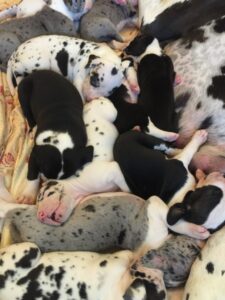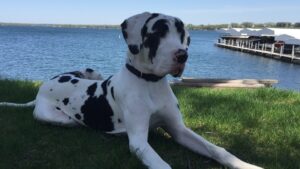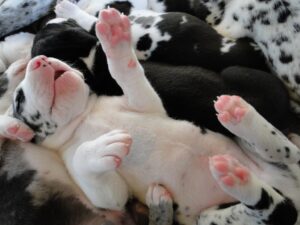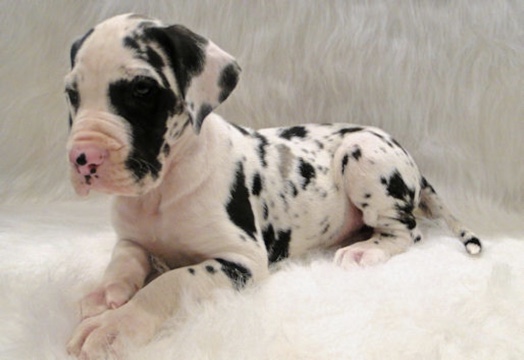
Litter News
Take a look at all of the planned N2Spots Great Danes litters

Breed News
Stay updated with quick-read content about the Great Dane breed

Puppy Updates
Follow along with our puppies as they join their new families
Adoption Process
Puppy Application
The Great Dane: Everything You Need to Know as a New Owner
The Great Dane is one of the most recognizable dogs in the world. These huge pups are big, powerful, and immensely strong. While their size has made them famous, their friendly nature has also given the status as one of the more popular family dogs in America.
The Great Dane standard breed colors are Black, Mantle, Merle, Fawn, Brindle, & Harlequin.
Other amazing colors and markings that are now recognized by AKC include,
– Piebalds in black, blue, merle, and harlequin,
– Blue in solids, merles, harlequins, mantles, blue fawns, blue fawn merles,
– Blue & black tan points and brindle points,
– Lilac in solids, merle, harlequins, and mantles.

Why was the Great Dane bred?
While their name might make you think that these dogs come from Denmark, they’re actually from Germany. Known as the Deutsche Dogge, the dogs were originally bred for hunting wild boar.
Since they needed to combat enormous weights, sharp tusks and strong fighters the Great Dane was originally very fierce. They were later incorporated into expensive estates as guardians and adopting a Great Dane into the family as a guard dog is still popular. These pups are thought to have been around for 400 years, maybe even more! Giant dogs, similar in looks to the Great Dane, have appeared on monuments and in artwork from ancient Egypt, Tibet, Greece, and China. There’s a long, rich history behind this wonderful breed.
Fun Quick Facts
Did you know Scooby-Doo is a Great Dane? During the show’s production history he was originally named “Too Much.”
When deciding on a breed, showrunners Joe Ruby and Ken Spears were stuck between creating a very brave but tiny pup or a large cowardly one. They chose the second option, renaming the character “Scooby-Doo,” and decided on a Great Dane. This is especially fitting as Great Danes were thought to ward away ghosts and evil spirits during the Middle Ages. Scooby-Doo was drawn with several odd physical characteristics to make him funnier and he even plays the bongos!
Great Danes are also known as the tallest dog in the world! Most of the pups measure at 2.5 to 2.8 feet tall, making them one massive member of the family. There’s a bit of debate about their status as the tallest since the Irish Wolfhound can grow a tiny bit taller depending on the breeder, but the tallest dog on record was a Great Dane named Zeus and for most this has settled the debate.
Environment
Your furry friend is going to need a lot of room to exercise! If you’re an apartment dweller you need to be prepared to take these big pups out for a long walk a few times per day so they can blow off some steam. Make sure you stay with them and make them part of the family! A big yard can be a fun space for the Great Dane, but these are indoor dogs that are excellent with families and other pets.
Another reason to keep these pups indoors is that they don’t have a subcutaneous fat layer or the skin and fur combo that would help them with the weather. They aren’t built for cold temperatures or extreme heat, so they shouldn’t live outdoors!
We offer lifetime breeder support for our puppies. Knowledge, dedication and building relationships are the key to any success as a breeder and a owner.
Training and Exercise
Socialization, obedience training, 2-3 walks daily, puppies need 90 minutes daily, easy to train Great Danes are massive and loud, so obedience training to keep them in line is going to be a must. Like most dogs, they can be destructive if bored and untrained. To prevent this, you should keep consistent and steady with your furry friend. Great Danes are known to be easy to train, though stubborn individuals exist within all breeds.
Socializing your puppy early can help them grow into a calm, well-adjusted adult. Slowly introducing them to your friends and family, as well as other pets, will help them to know how to behave around others and make for a friendly pup!
Adult Great Danes can be relaxed and calm, but they need to get their exercise. A few quick walks per day, 2 to 3 should do, and they’ll be content and healthy. With puppies, it’s recommended that you should exercise them at least 90 minutes a day to promote healthy growth and development.
Grooming
While their short, shiny coat might lead you to believe they won’t shed much, the Great Dane is considered a “moderate” shedder. You’ll need to brush your friend once a week to prevent excess hair in your carpet. Be prepared for the “blowout,” a huge shedding that will occur in the spring and fall each year. You’ll need to be ready to brush more often during these times. Other than that it is relatively easy to care for a Great Dane. They can be bathed as often as you like without damaging their coat. Keep their nails trimmed every few weeks and brush their teeth regularly to keep their chompers sparkling.
Health
These pups grow fast and can reach their full height within a year, though most take between 2 and 3 years. This quick growth pattern comes with an unfortunate side effect – the Great Dane only lives 6 and 8 years. Their lives are quite brief, and anyone looking to adopt one needs to be aware of this.
Besides their short life-span, the Great Dane has a few health issues to deal with. Hip dysplasia, which is an occurrence when the ball and socket of a joint don’t fit together properly, can develop into an issue for some of these dogs. It’s important to have your companion checked regularly. To completely avoid the issue, check with the breeder to ensure that both parents are free of hip dysplasia.
Great Danes can also suffer from bloat, an expansion of the stomach with air. This can be dangerous, as the pup’s stomach has the potential to twist. This is a life-threatening issue and will need to be surgically taken care of immediately to save the dog’s life. Your veterinarian can also tack their stomach to prevent twisting in the future. Keep a serious eye on this, as bloat is the number one killer of Great Danes!
Heart disease is a potential issue, and you should regularly have them checked for a few issues. The most important thing to look out for is cardiomyopathy, which is an enlargement of the heart. This is easily managed with medication if it occurs later in their lives. The biggest issue to look out for is bone cancer. Great Danes, like all large dogs, can have skeletal issues. Cancer, however, is quite common in this breed and should be checked regularly. This is one of the leading causes of death in these pups and needs to be watched for.
Big dogs often mean big veterinarian bills, and the Great Dane is no exception. Be prepared toregularly have your pup tested for these potential issues and to have money set aside to pay forany medications or surgeries that might be required.



